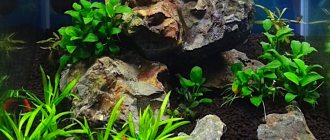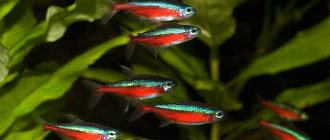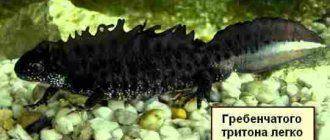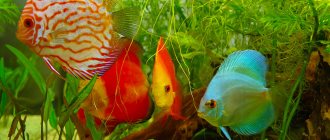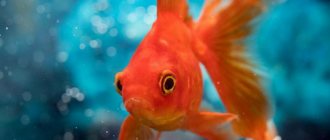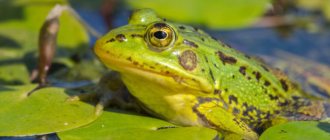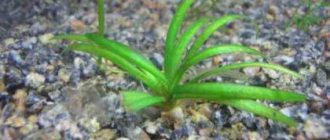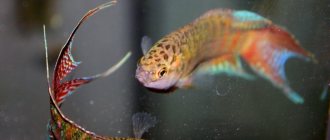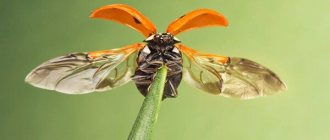Schisandra or Nomaphyla directa.
Distribution: Southeast Asia.
Schisandra or Nomaphila straight (Nomaphila stricta, Nomaphila corymbosa) is a popular plant among aquarists because... has high decorative qualities.
Has a long strong stem. On which oval, pointed leaves are arranged in pairs, light green in color with a silvery underside. Place the plant in the background of the aquarium. Grows in an aquarium all year round.
Comfortable water parameters for keeping lemongrass in an aquarium : temperature 24-27 ° C (a decrease in temperature slows down growth, the size of the leaves decreases). Hardness not less than 8°, pH 7-8.5. In soft water, the leaves quickly collapse, only the top remains. The plant needs a weekly change of 1/4 volume of water.
The plant loves strong light. With a lack of light, the leaves quickly turn pale and fall apart. Natural light improves plant growth. Side lighting helps keep more old leaves on the stem. The duration of daylight is at least 8-12 hours. The lighting intensity for lemongrass is from 50 Lm/l. The plant can easily leave the aquarium and continue to grow in its above-water form.
A nutritious soil is needed - a substrate. Tablets like Tetra Crypto, etc. are added to the new soil without a base under the roots. The thickness of the soil layer is at least 5-7 cm. Nomanfila straighta is propagated by cuttings: shoots are separated from the mother plant.
Description
The lemongrass plant, which has a pleasant citrus aroma, is often called swampweed. It grows well in fresh water.
The plant has a straight and elastic stem. The sheets have characteristic features:
- Silvery shade on the back side, greenish on the front side.
- Shape: oval with a slight point.
- All veins are clearly visible.
- Length – 120 mm, height – 300 mm, width – 30 mm.
Schisandra grows quickly in a standard aquarium. Therefore, its height often exceeds the height of the tank. Leaves that appear out of water are distinguished by their roughness and relief.
Schisandra is used not only for the aquarium. It is used to create a paludarium that combines air and water environments.
See what lemongrass looks like in an aquarium.
Maintenance and care of the aquarium plant Schisandra
Under optimal conditions, Nomaphyla grows all year round and reaches the surface of the aquarium. Therefore, to grow it, it is recommended to choose a vessel at least 55 cm high. It is best to plant lemongrass in large-volume aquariums, and it will be able to grow to its maximum size and come to the surface.
A warm-water tropical aquarium is optimal for nomaphila. The plant loves warmth very much, so the water temperature is required in the range from 22 to 28 degrees. A lower temperature will certainly lead to the growth of lemongrass stopping and the leaves becoming smaller.
The conditions for keeping the aquarium plant Schisandra require bright lighting. It should grow directly under a powerful lamp and then the nomaphila leaves will be healthy and rich in color. As soon as it becomes too dark for the plant, the lemongrass will become paler and smaller. The approximate power of the lamps is from 0.5 W/1l. volume of water. The duration of illumination is twelve hours.
For the growth of nomaphila, nutritious soil with the addition of silt, clay, and charcoal is required. The thickness of the soil is at least 5 cm for rooting the stem.
When keeping such a plant in an aquarium, you need to change a fifth of the water every week. For lemongrass, water hardness plays an important role - it must be at least 8 ° C; soft water is not suitable for the plant and its leaves begin to collapse.
It is recommended to renew Nomafila at least twice a year . It propagates by simple cuttings. Shoots of approximately 7 centimeters are separated, planted in the ground and they quickly take root. This ensures good growth, the plant begins to bush even more and produce new cuttings. It is recommended to plant it in a group.
Little tricks for growing plants and propagating them
- It is recommended to plant all varieties of Nomafil in a group. To make them grow faster, you can shorten the stem.
- A tall plant that has reached the surface of the aquarium may shed its remaining leaves under water.
- Cuttings are an easy way to propagate lemongrass. Young roots and leaves appear on the mother plant. They are separated by cutting off the top of the adult by approximately 7 cm. The shoots are planted in previously prepared soil.
- An adult lemongrass does not suffer at all from this procedure.
It begins to bush even more and forms new cuttings. When growing a tropical guest in an aquarium, you should pay attention to: - Lighting.
- Soil properties.
- Water.
- Feeding.
Temperature conditions.
Schisandra does not tolerate cold. The ideal temperature for it is from 22 to 280 C.
The plant is suitable for a soft or medium-hard water environment. It must be clean. Once a week, the water is partially changed (up to 30% of the liquid volume).
Nomafile needs intense lighting. The duration of her daylight hours is 12 hours. It is recommended to select fluorescent lamps so that for every 1 liter of volume there is 0.5 W of their power.
Schisandra loves direct sunlight.
The plant will like it if you place the aquarium on the windowsill or as close to the window as possible. Incandescent lamps create additional side lighting. Such a lighting system will allow you to preserve old leaves for a long time.
Soil requirements:
- Sufficient concentration of nutrients, a lot of sludge.
- The thickness of the soil layer at the bottom of the aquarium is 5-7 cm.
- When transplanting nomaphila, clay is placed under the roots.
- The nature of the substrate itself does not play a big role, since the plant has strong roots.
- Schisandra is very sensitive to changes in the environment. A sharp disturbance of living conditions can cause illness. Considering this, you should not get carried away with fertilizing.
- Nomafil reacts especially hard to high concentrations of sodium ions. Baking soda and table salt are added to water with great care.
The plant will actively develop in the paludarium and greenhouse. Much faster than in an aquarium. It immediately grows in a low container filled with water. After the formation of aerial shoots, the lemongrass is transplanted into the soil.
You can take a cutting from a nomaphila grown in this way and transplant it into an aquarium. The shoot easily adapts to new conditions and will continue to develop. Armed with the necessary knowledge, it is easy to create ideal conditions for growing fish in your aquarium.
Nomaphyla serrata
Nomaphila serrata is much better known to aquarists . Its exact species identity has not yet been established and the plant is listed under the commercial name N.sp. “Densely leafed”.
It differs from the previous species in having wider leaves and a darker color of the leaf blade. A clearly defined serration is visible along the edge of the leaf, which is well preserved in the above-water leaves. The whorls of leaves are located further apart on the stem than in previous species, which affects the decorative qualities of the plant. The conditions of detention are similar to those described above. It is not possible to grow this nomaphyla in soft water for a long time, as it begins to shrink and shed old leaves.
The tops of the plant gradually die, but the stems remain for quite a long time, but growth does not resume. In a tropical aquarium in water of medium hardness with sufficient lighting, this nomaphyla develops quite satisfactorily, but it is not at all interesting when exposed to air. Therefore, its stems that have reached the surface of the water must be cut - then the plant bushes and forms many shoots at the base of the stem. In some cases, long stems are pressed to the ground, but in this case the top grows the fastest, and there is almost no tillering. This nomaphyla, like other species, is propagated by cuttings.
Kinds
There are a large number of varieties of aquarium lemongrass known, but only some species are used to decorate a home aquarium. These include several varieties of the plant.
- Narrow-leaved. The main distinguishing feature of this plant is its highest growth rate compared to other species. Please note that in fairly soft water environments this species may shed its leaves and the stem will be bare on the top few layers. The plant also loves a lot of light, replacing a small amount of water in the aquarium (1-2 times a week).
- Dwarf. This type of aquarium lemongrass is distinguished by its rather short epicotyls and very dense foliage, which is located close to each other. It is also worth noting that this type of aquarium plant is beginning to gain popularity among aquarium enthusiasts.
- Willow leaf. It is considered one of the most unusual species, since the same species can look completely different depending on the location. Features include a thin and flexible stem, as well as narrow and very thin leaves that are able to wriggle along with the flow. The plant loves bright light and does not tolerate liquid forms of fertilizer. In addition, this variety can serve as an indicator of the aquatic environment, you just need to pay attention to the change in the foliage of the plant: white bloom – iron deficiency; yellowing or rapid death - lack of nitrates; holes in the foliage - lack of calcium.
Schisandra aquarium plant in open ground
Contrary to book recommendations, I acted differently and did not transplant Nomaphyla into a wet greenhouse or paludarium, but transplanted it into open ground. Does nomaphila grow in air above water and not die? I cut two plants growing above the water and transplanted them into a plastic container.
As a nutrient soil, I used garden soil with a layer of 8-10 cm, and so that the plant had enough moisture, and it did not dry out and took root faster, I filled the free space in the container with water. A week has passed. My aquarium plant Schisandra grows on a windowsill in the open ground and feels great.
How to choose?
In order to create a beautiful and comfortable aquarium for your fish, some part of its perimeter should be occupied by algae. They will help create a beautiful look. Unlike artificial vegetation, live aquarium plants will provide benefits to your pets.
The choice of aquarium algae should be approached with due care. And lemongrass is no exception. To begin with, it is worth noting that algae for an aquarium can be divided into 3 categories according to their location: in the back, in the middle and in front of the aquarium.
Schisandra can usually be found either in the middle part or in the background of the aquarium (depending on the species).
To choose a good “seedling” for your aquarium, you should pay attention to several external signs. These include several factors.
- The stem should be a darker color compared to the foliage. And also it should not be too thin.
- The leaves should look healthy, without any plaque or blotches. Their color is usually slightly lighter than the stem. Depending on the plant variety, the back of the leaves may be a different color from the front, but this may not always be a bad sign.
- The roots must be at least 2-3 centimeters so that the plant can take root well in the soil of the aquarium. Make sure that the roots are without any damage.
What are the benefits of lemongrass?
Thai lemongrass is used in aquariums for its decorative properties. After all, the plant is distinguished by its density and elegance.
Algae is planted in a tank for another reason. They act as a filter that eliminates organic matter and the remains of the vital activity of individuals. They saturate the container with oxygen and remove remaining carbon dioxide.
Life cycle
Experienced aquarists note that with proper care, life expectancy can be measured in decades. This is due to the continuous cycle of reproduction.
Algae growth is the same throughout the year. After all, lemongrass “does not hibernate.”
Compatibility with the “residents” of the aquarium
Experienced aquarists do not plant lemongrass in tanks with ancistrus and cleaners. After all, these fish actively absorb the foliage of these plants.
Nomaphyla is planted in containers with other algae and shady plants. You should not plant them with those species that require shortened daylight hours. After all, this provokes a deterioration in appearance.
Schisandra is characterized by active growth. Therefore, it spreads throughout the tank, and other plants begin to rot and stop growing. The solution is simple - growth control, periodic pruning of “adult” plants, transplanting into other tanks and containers.
Algae should not be planted in close proximity to other plant varieties, decorative elements and driftwood.
Algae are not planted in tanks in which pistia grows. After all, pistia prevents their growth.
Diseases and treatment
Spots and other damage to algae appear due to the fact that the balance of key parameters is disrupted.
Problems and solutions
- The temperature of the aquarium water decreases. This provokes stunting of growth and deterioration of the leaves. Sometimes spots appear.
- Lack of light. When using a low-power lamp, the vegetation becomes less lush. Therefore, before installing a lighting device, experienced aquarists carry out calculations. This allows you to set the optimal power of the fluorescent lamp.
- Lack of rigidity. Specks are formed at reduced rigidity parameters. If the required balance of hardness is not restored, then the lemongrass is completely destroyed.
- Lack of substrate. Spots do not form with a thin layer of soil. The development of algae stops.
Spots are not the only sign of the disease. The absence of flowers also indicates non-compliance with the rules of care.
When diseased, the dark stem becomes lighter and becomes covered with microcracks. Therefore, periodic inspection is an important step in caring for this plant.
To create a harmonious environment in the aquarium, a responsible approach to the choice of vegetation is required. And lemongrass is the best option for small and large containers with fish. After all, it is compatible with many phenotypes and representatives of the fauna. Its planting is carried out without complex preparatory processes.
Reproduction
Schisandra propagates by cuttings. Cut off the top shoot and place it in the ground. To protect developing roots from being dug up by aquarium fish, place the plant in a pot. For planting, select a small container, otherwise the nomafila will develop a root system without growing tall. The cutting can be left unrooted, but the resulting shoots may grow uneven.
View this post on Instagram
Publication from MankinaRybki (@mankinyrybki) March 2, 2022 at 11:06 PST
Diseases
With proper care, nomaphila blooms and pleases the eye, and there are no spots or growths on the leaves and stems. If conditions are violated, the plant becomes ill, as evidenced by the following signs:
- loss of integrity of leaves and small spots on them - the reason lies in too soft water;
- large dark spots – low water temperature; poor development and fragility - small thickness of the substrate;
- light or pale yellow spots – magnesium deficiency;
- leaves turn yellow and change shape, curling - lack of potassium;
- dying leaves - lack of lighting or too soft water;
- discoloration and purple spots on the leaves are a lack of nutrients.
Maintenance and care in the aquarium
First of all, it is worth noting that to keep a nymph you will need a large aquarium, at least 250 liters.
Its large leaves will block the light, so proper placement of the rest of the vegetation will be required. The water lily prefers warm water. The optimal temperature for its comfortable maintenance should be within 25-28 degrees. If it drops even a couple of degrees, the growth of the nymph will stop, and flowering will not occur at all.
With increased rigidity, the water lily produces many small leaves under water and turns into a bush. In such conditions, it practically does not bloom, so if you want to see water lily flowers, you will have to soften the water. It is also necessary to maintain a slightly acidic balance and a high concentration of humic acids. Simply put, frequent water changes will not be required.
Nymphea prefers a lot of light. Otherwise, it fades, the cuttings lengthen, and the plant itself loses its special shape and structure, growing chaotically. The ideal light for water lilies is the sun's rays, but in aquarium conditions you can install fluorescent fluorescent lamps. The power is selected based on the calculation of 0.5 W per liter of volume. Such lighting is actively used in greenhouses and greenhouses. They can be replaced with special phytolamps.
It is not recommended to use incandescent lamps as the main light, because their power will not be enough. In addition, they heat the water. They are installed as an additional source of rays of the red-orange spectrum. In order to achieve flowering of a water lily, you will need to maintain a daylight hours of at least 12 hours.
Suitable soil for nymphs is a silted substrate that contains a large amount of organic matter. Despite the fact that the roots of the plant are powerful and strong, they are very vulnerable and can be damaged by sharp stones. Therefore, it is better to use small pebbles. Clay, charcoal and peat are added to the soil as fertilizers.
In order to achieve flowering of a water lily, you will need to maintain a daylight hours of at least 12 hours.
In order to grow a healthy and strong plant that is capable of blooming, you can plant nymphs in separate pots:
- Pebbles are poured onto the very bottom of the container;
- Next comes a layer of soil. It consists of substrate, sand and clay;
- A nymph is planted in the ground;
- The remainder of the container is filled with pebbles and coarse sand.
This method of separate planting allows you to achieve the correct soil composition and the development of a powerful root system that will not be oppressed by other flora.
Direct nomaphilia diseases
As already mentioned, lemongrass is a rather capricious plant and if the favorable environment is disturbed, it may experience various growth deviations and even diseases. Let's look at some of them.
So, with poor lighting, a rapid death of vegetation is observed, and in the absence of any restoration measures, soon only a bare stem with a huge amount of fallen dense vegetation at the bottom can be observed. Another negative factor is the presence of too soft water, which has a destructive effect on the greenery of the plant. It is also impossible not to say about the thin level of soil, which will be the main reason for the poor development of the plant.
In addition, to maintain the appearance of nomaphila in ideal condition, it is recommended to carry out rejuvenating procedures at least once every 6 months. This is necessary for the appearance of small shoots with small leaves on the plant. And most importantly, being in an unhealthy state, lemongrass will not be able to bloom, which will deprive any aquarist of the opportunity to see the incredibly beautiful picture of the appearance of bluish-lilac flowers above the surface of the water.
Hygrophila corymbosa, Schisandra, Hygrophila corymbosa
Family: Acanthaceae (Acanthaceae). Synonyms: Nomaphila corymbosa Blume (1826), Justica stricta Vahl, Nomaphila stricta (Vahl) Nees, Hygrophila stricta (Vahl) Lindau, etc. Trade name: H. “lacustris”, H. “siamensis”, H. “longifolius” and etc. Etymology: Hygrophila: hygros - wet, philein - to love, by habitat, corymbosa corymbosa, by inflorescence. Distribution: Widely distributed in Southeast Asia.
Description: marsh plant with an erect, branched stem up to 5 mm thick. The plant is naked (except for one form). The leaf arrangement is cruciform-opposite. Petiole 1-5 cm. Many genetically fixed, sterile plant forms are cultivated, the leaf blades of which vary greatly in shape and size.
Broad-leaved form: the leaf blade is narrow-ovate or elliptical, emergent, 6-8 cm long, 2.5-3.0 cm wide; underwater 10-20 cm long, 3-7 cm wide. There are pure olive-green or red-brown colored forms.
Thailand form: emergent leaf blade narrowly elliptical, 7-10 cm long, 1.5-2.5 cm wide, submerged leaf blade narrowly lanceolate, 10-20 cm long, 1.5-2.0 cm wide; one colored form with light green and the other with red-brown leaves. Pubescent form: an emergent plant (including the underside of the leaves), densely pubescent (almost bare at high air humidity), strongly aromatic. The emergent leaf blade is narrowly elliptical, 4–7 cm long, 1–1.5 cm wide; the underwater plate is linear, 1–30 cm long, 0.5–1.5 cm wide, light green.
The inflorescence is a dichasia with three to several flowers and a peduncle 0.5-2 cm long. Bract petals are 2-2.5 mm long and 0.5 mm wide. Individual flowers range from light blue to deep blue-violet. It has 5 sepals, hairy, 4-8 mm long, one of them is 1-3 mm longer than the others. The flower in the lower part grows together into a tube; corolla bilabial, 10-15 mm long. The upper lip is bifid; the lower lip is 3-parted, wrinkled-convex and with a white-blue pattern. It has 4 stamens, two of which reach almost the edge of the upper lip, while the remaining 2 are shorter. The pistil is up to 1.3 cm long. The carpels are cylindrical, 3.5 x 1.5 cm long. The capsule is 1-1.3 cm long, with 20 flat, almost round seeds.
Culture: all plant forms are fast growing and are recommended for keeping. Although in general their need for lighting is very moderate, the shoots become much more powerful and larger with more intense lighting. Red colored shapes look most beautiful in a free, bright place. Pebbles or washed sand are sufficient as soil, however, the shoots become larger and more powerful on nutritious soil or when appropriate fertilizers are added. H. corymbosa grows well in slightly alkaline water from medium to hard, with an optimal temperature range of 24-28 C. Surprisingly good growth rates are observed in water with a strong current, for example, near the filter outlet. This plant makes its greatest impression in a small group in the center or background of the aquarium. Over time, under good conditions, side shoots form, giving the group of plants a bushy appearance. These side shoots, 10 cm in size, can be separated and further used as cuttings.
Hygrophila corymbosa is usually sold as a terrestrial crop and in most cases loses its emergent leaves when planted in an aquarium; however, the plants continue to develop well in water and soon produce new leaves.
Ecology: the plant inhabits marshy biotopes. Two very different habitats have been observed on Sulawesi. Near Bantimurung, in a small river with a fast current, a narrow-leaved form with a small number of flowers grew both underwater and above water. Water analysis: temperature 28 °C; pH 7.5; GH 7.8 dH; KH 6 dH; 300 j.S/cm. In another habitat near Angkona, a fully terrestrial, broad-leaved, multi-flowered form grew only in moist soil.
Common varieties
Serious competitors of ordinary lemongrass are Nomafila serrata and Nomaphila thailandica. They are often the choice of discerning aquarists:
- Toothed algae has leaves with a sparser arrangement, on the edges of which there are pointed formations. Because of this feature, the plant does not require a lot of bright light. The leaves of Schisandra angustifolia, located in the upper part, do not create a strong shadow, so the lower branches receive enough light.
- The Thai variety always looks elegant in an aquarium. It is distinguished by small leaves that densely cover the stem. The general shape of this algae is very similar to a branched and lush shrub.
Habitat
Under natural conditions, lemongrass is found in water bodies of Southeast Asia. This species loves shallow waters, but can also grow along the coast of larger lakes and ponds. This is a semi-aquatic crop that thrives in both water and air.
Nomaphyla leaves are arranged crosswise and give the impression of a regular geometric pattern.
In aquariums, nomaphila grows year-round, actively and quickly. High aesthetic values make this representative of the aquatic flora a favorite among other aquarium crops. Especially considering the ease and simplicity of care.
Reviews
The experience of aquarists varies greatly: for some, Schisandra grows very quickly, which is the reason for abandoning the plant, for others, nomaphila does not take root or grows very slowly.
The combination of lemongrass in an aquarium with floating plants creates an impressive decorative effect. Nomaphyla is common in Dutch-style aquariums. This plant is often confused with hygrophila.
Next
Plants Hemianthus micranthemoides is a long-stemmed freshwater plant
What problems might you encounter?
For lemongrass, it is extremely important to comply with all the requirements established for it regarding the composition of water and illumination. If the rules are not followed, the plant begins to wither and get sick. All shortcomings will be evidenced by a change in culture:
- poor stem growth, shredding of leaves, their fragility: decreased temperature of the water layer;
- falling leaves, exposure of the plant stem: too soft water environment;
- poor crop growth: excessively thin soil layer;
- death of deciduous mass: lack of light;
- change in the color of the leaves, the appearance of spots on them: lack of nutrients.
Schisandra can also bloom with small flowers of unusual beauty. If the plant feels uncomfortable, gets sick and weakens, it will not bloom.
The lifespan of an aquatic plant also depends on attention and proper care. In skillful hands, lemongrass grows continuously, shoots change each other, providing the culture with an almost endless life. Under comfortable conditions, lemongrass can increase its growth by up to 10-12 cm per week.

